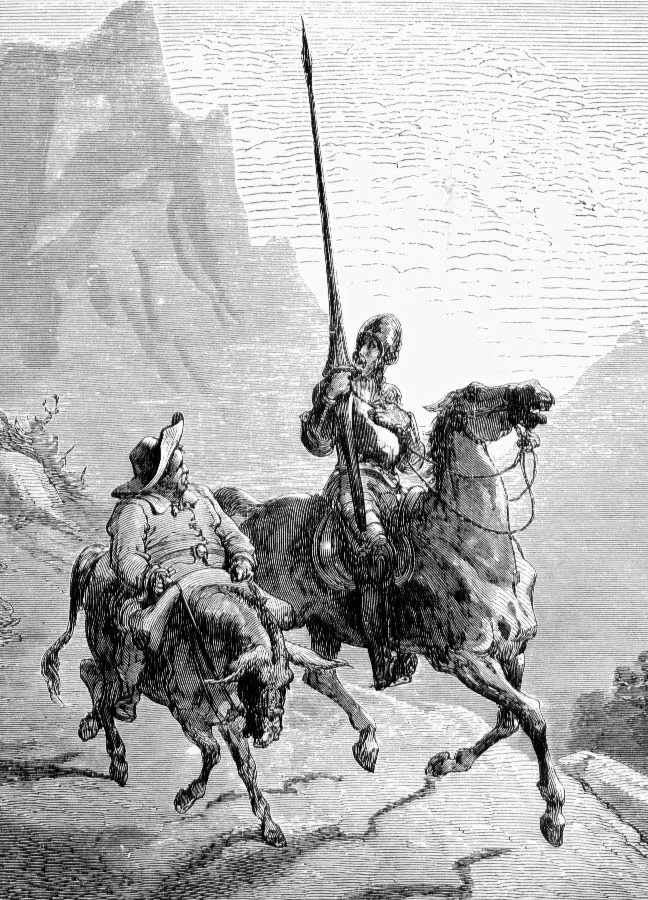Before a fit of madness turned Alonso Quijano into Don Quixote, Sancho Panza was indeed his servant. When the novel begins, Sancho has been married for a long time to a woman named Teresa Cascajo and has a daughter, María Sancha (also named Marisancha, Marica, María, Sancha, and Sanchica), who is said to be old enough to be married. Sancho’s wife is described more or less as a feminine version of Sancho, both in looks and behaviour. When Don Quixote proposes Sancho to be his squire, neither he nor his family strongly oppose it. Sancho is illiterate and proud of it but by influence of his new master, he develops considerable knowledge about some books. Sancho instead provides the earthy wisdom of Spanish proverbs, surprising his master. During the travels with Don Quixote, he keeps contact with his wife by dictating letters addressed to her. Sancho Panza offers interpolated narrative voice throughout the tale, a literary convention invented by Cervantes. Sancho Panza is precursor to “the sidekick,” and is symbolic of practicality over idealism. Sancho is the everyman, who, though not sharing his master’s delusional “enchantment” until late in the novel, remains his ever-faithful companion realist, and functions as the clever sidekick. Salvador de Madariaga detected that, as the book progresses, there is a “Quixotization” of Sancho and a “Sanchification” of Don Quixote, so much that, when the knight recovers sanity on his deathbed, it is Sancho who tries to convince him to become pastoral shepherds. In the novel, Don Quixote comments on the historical state and condition of Aragón and Castilla, which are vying for power in Europe. Sancho Panza represents, among other things, the quintessentially Spanish brand of skepticism of the period. Sancho obediently follows his master, despite being sometimes puzzled by Quixote’s actions. Riding a donkey, he helps Quixote get out of various conflicts while looking forward to rewards of aventura that Quixote tells him of.
| Alias Sancho Panza |
| Real Names/Alt Names Sancho Panza |
| Characteristics Hero, Sidekick, Literary Characters, Scientific Revolution, Spanish |
| Creators/Key Contributors Gustave Doré, Miguel de Cervantes |
| First Appearance The Ingenious Gentleman Don Quixote of La Mancha (1605) |
| First Publisher Francisco de Robles |
| Appearance List Literature: The Ingenious Gentleman Don Quixote of La Mancha (1605) by Miguel de Cervantes, Part 2 (1614) by Alonso Fernández de Avellaneda, Part 2 (1615) by Miguel de Cervantes, Vida de Don Quijote y Sancho (1914) by Miguel de Unamuno. Film: Don Quixote (1906), Don Chisciotte (1911), Don Quixote (1915). Comics: Wonderworld Comics #4 (August 1939), Wonder Comics #2 (June 1939), Samson #2 (December 1940-January 1941), Jumbo Comics #32 (October 1941), Giggle Comics #57 (September 1948), Classics Illustrated #11 – Don Quixote (May 1960). |
| Sample Read Don Quixote [PG] |
| Description Before a fit of madness turned Alonso Quijano into Don Quixote, Sancho Panza was indeed his servant. When the novel begins, Sancho has been married for a long time to a woman named Teresa Cascajo and has a daughter, María Sancha (also named Marisancha, Marica, María, Sancha, and Sanchica), who is said to be old enough to be married. Sancho’s wife is described more or less as a feminine version of Sancho, both in looks and behaviour. When Don Quixote proposes Sancho to be his squire, neither he nor his family strongly oppose it. Sancho is illiterate and proud of it but by influence of his new master, he develops considerable knowledge about some books. Sancho instead provides the earthy wisdom of Spanish proverbs, surprising his master. During the travels with Don Quixote, he keeps contact with his wife by dictating letters addressed to her. Sancho Panza offers interpolated narrative voice throughout the tale, a literary convention invented by Cervantes. Sancho Panza is precursor to “the sidekick,” and is symbolic of practicality over idealism. Sancho is the everyman, who, though not sharing his master’s delusional “enchantment” until late in the novel, remains his ever-faithful companion realist, and functions as the clever sidekick. Salvador de Madariaga detected that, as the book progresses, there is a “Quixotization” of Sancho and a “Sanchification” of Don Quixote, so much that, when the knight recovers sanity on his deathbed, it is Sancho who tries to convince him to become pastoral shepherds. In the novel, Don Quixote comments on the historical state and condition of Aragón and Castilla, which are vying for power in Europe. Sancho Panza represents, among other things, the quintessentially Spanish brand of skepticism of the period. Sancho obediently follows his master, despite being sometimes puzzled by Quixote’s actions. Riding a donkey, he helps Quixote get out of various conflicts while looking forward to rewards of aventura that Quixote tells him of. |
| Source Sancho Panza – Wikipedia |

